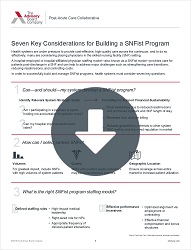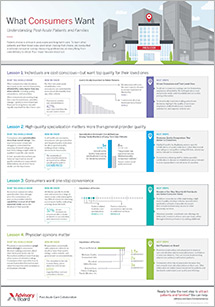Auto logout in seconds.
Continue LogoutOver the past decade, more than 440 rural nursing homes across the country have closed, forcing residents to relocate to new facilities that may be hundreds of miles away from their family and friends, Jack Healy reports for the New York Times.
What do consumers want from post-acute care?
The nursing home 'crisis' in rural America
Nursing homes are closing in record numbers in rural states, Healy reports. Last year, five nursing homes closed in Nebraska and a record six nursing homes closed in Maine—and even more are at risk of closing or merging, according to Healy.
The majority of the more than 440 U.S. nursing homes that closed in the past decade were forced to end operations for financial reasons, Healy reports. Thirty-six closed because of non-compliance with health and safety standards.
According to Healy, nursing homes' financial troubles stem in part from new health care policies that aim to keep patients in their own homes or in an assisted or independent living facility. Those changes, Healy reports, have caused nursing home occupancy rates to fall.
Finding a reliable workforce has also been a challenge, Healy reports, as some nursing homes are struggling to find people who are willing to care for their residents at typically low pay.
In addition, Healy reports nursing homes that largely serve Medicaid populations struggle with reimbursement rates so low that nursing homes can't afford "to keep the lights on." In states such as South Dakota, where the majority of nursing home residents rely on Medicaid, the reimbursement rates have resulted in a "crisis," Healy writes.
Mark Deak, executive director of the South Dakota Health Care Association, said South Dakota's Medicaid program has the lowest reimbursement rate for long-term care residents in the country. As a result, nursing homes in the state lose about $58 per day per resident on Medicaid, which adds up to $66 million in losses per year, Deak explained.
Relocations are 'traumatiz[ing]' for nursing home patients and relatives
Stephen Monroe, a researcher who studies aging in America, said in some rural communities "[t]here are no alternatives" that can provide nursing home care after a facility closes, meaning the residents of those homes must relocate—sometimes to facilities hundreds of miles away or in different states.
For example, when the South Dakota-based Mobridge Care and Rehabilitation Center was shut down for poor financial performance, residents were given just two months to find a new place to live. Some residents were moved hundreds of miles away.
The sudden relocations can be "traumatic" for patients whose homes, families, and friends are near the closed location, Healy reports. Some relatives of relocated patients said they can see their loved ones only one day per week, while others said they simply cannot make the drive to the patients' new locations—rendering the patients essentially cut off from their hometowns, family, and friends, according to Healy.
Justin Van Orman used to visit his 79-year-old father numerous times per week when his father lived at Mobridge, but when his dad was relocated to a nursing home 50 miles away, things changed. Now, when Van Orman gets a call from the nursing home that his father has fallen out of bed, he must decide whether to shift his schedule for the entire day to check on his dad in person.
"Before, I could just drop by five days a week. He knew I was there," Van Orman said (Healy, New York Times, 3/4).
What do consumers want from post-acute care?
Patient choice is critical in post-acute and long-term care. To learn what patients and their families want when making that choice, we conducted a national consumer survey measuring preferences on everything from care delivery to decor. Four major lessons stood out.
Get our infographic to find out if high-quality specialization matters more to consumers than general provider quality, why patients want one-stop convenience, and more.
Don't miss out on the latest Advisory Board insights
Create your free account to access 1 resource, including the latest research and webinars.
Want access without creating an account?
You have 1 free members-only resource remaining this month.
1 free members-only resources remaining
1 free members-only resources remaining
You've reached your limit of free insights
Become a member to access all of Advisory Board's resources, events, and experts
Never miss out on the latest innovative health care content tailored to you.
Benefits include:
You've reached your limit of free insights
Become a member to access all of Advisory Board's resources, events, and experts
Never miss out on the latest innovative health care content tailored to you.
Benefits include:
This content is available through your Curated Research partnership with Advisory Board. Click on ‘view this resource’ to read the full piece
Email ask@advisory.com to learn more
Click on ‘Become a Member’ to learn about the benefits of a Full-Access partnership with Advisory Board
Never miss out on the latest innovative health care content tailored to you.
Benefits Include:
This is for members only. Learn more.
Click on ‘Become a Member’ to learn about the benefits of a Full-Access partnership with Advisory Board
Never miss out on the latest innovative health care content tailored to you.


